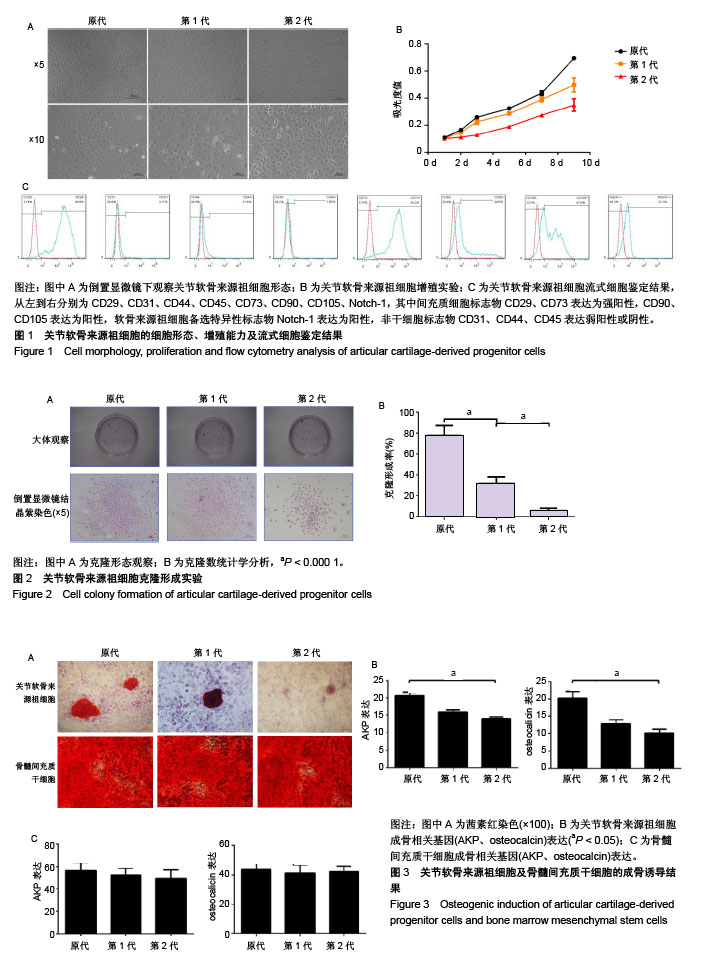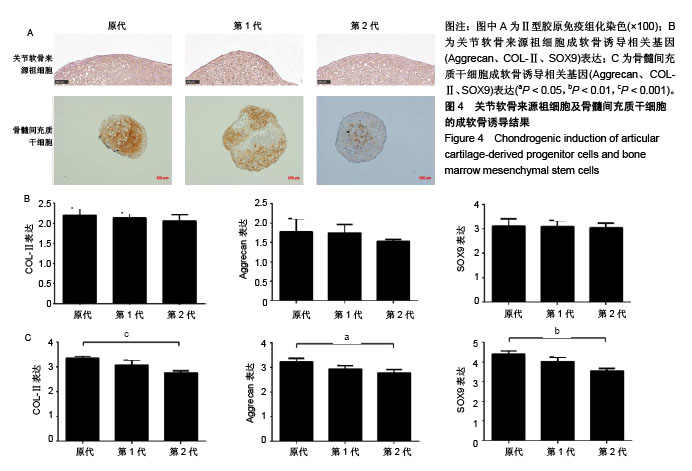| [1] Jiang Y, Tuan RS. Origin and function of cartilage stem/progenitor cells in osteoarthritis. Nat Rev Rheumatol. 2015;11(4):206-212.[2] Centers for Disease Control and Prevention (CDC). Prevalence of doctor-diagnosed arthritis and arthritis-attributable activity limitation- United States, 2010-2012. MMWR Morb Mortal Wkly Rep. 2013; 62(44): 869-873.[3] Felson DT. An update on the pathogenesis and epidemiology of osteoarthritis. Radiol Clin North Am. 2004;42(1):1-9.[4] Guilbert JJ. The world health report 2002 - reducing risks, promoting healthy life. Educ Health (Abingdon). 2003;16(2):230.[5] 张爽,刘石,汪宇峰,等.间充质干细胞修复骨关节炎软骨损伤的临床应用意义[J].中国组织工程研究, 2018,22(33):5379-5385.[6] Medvedeva EV, Grebenik EA, Gornostaeva SN, et al. Repair of Damaged Articular Cartilage:Current Approaches and Future Directions. Int J Mol Sci. 2018;19(8): E2366.[7] Mithoefer K, McAdams T, Williams RJ, et al. Clinical efficacy of the microfracture technique for articular cartilage repair in the knee: an evidence-based systematic analysis. Am J Sports Med. 2009; 37(10):2053-2063.[8] Nakagawa Y, Mukai S, Yabumoto H, et al. Serial Changes of the Cartilage in Recipient Sites and Their Mirror Sites on Second-Look Imaging After Mosaicplasty. Am J Sports Med. 2016;44(5): 1243-1248.[9] Solheim E, Hegna J, Øyen J, et al. Results at 10 to 14 years after osteochondral autografting (mosaicplasty) in articular cartilage defects in the knee. Knee. 2013;20(4):287-290.[10] Hangody L, Dobos J, Baló E, et al. Clinical experiences with autologous osteochondral mosaicplasty in an athletic population: a 17-year prospective multicenter study. Am J Sports Med. 2010; 38(6):1125-1133.[11] Goyal D, Goyal A, Keyhani S, et al. Evidence-based status of second- and third-generation autologous chondrocyte implantation over first generation: a systematic review of level I and II studies. Arthroscopy. 2013;29(11):1872-1878.[12] Derrett S, Stokes EA, James M, et al. Cost and health status analysis after autologous chondrocyte implantation and mosaicplasty: a retrospective comparison. Int J Technol Assess Health Care. 2005; 21(3): 359-367.[13] Mistry H, Connock M, Pink J, et al. Autologous chondrocyte implantation in the knee: systematic review and economic evaluation. Health Technol Assess. 2017;21(6):1-294.[14] Park YB, Ha CW, Rhim JH, et al. Stem Cell Therapy for Articular Cartilage Repair: Review of the Entity of Cell Populations Used and the Result of the Clinical Application of Each Entity. Am J Sports Med. 2018;46(10):2540-2552.[15] 李乔乔,吴振强,张丽君,等.骨髓间充质干细胞的定向分化潜能[J].中国组织工程研究,2017,21(25): 4082-4087.[16] Williams R, Khan IM, Richardson K, et al. Identification and clonal characterisation of a progenitor cell sub-population in normal human articular cartilage. PLoS One. 2010;5(10):e13246.[17] Pelttari K, Winter A, Steck E, et al. Premature induction of hypertrophy during in vitro chondrogenesis of human mesenchymal stem cells correlates with calcification and vascular invasion after ectopic transplantation in SCID mice. Arthritis Rheum. 2006;54(10): 3254-3266.[18] 赵文慧,皮洪涛,冯万文,等.关节软骨细胞和骨髓间充质干细胞不同共培养方式对细胞增殖与分化的影响[J].中国组织工程研究,2019,23(1): 24-29.[19] Marcus P, De Bari C, Dell'Accio F, et al. Articular Chondroprogenitor Cells Maintain Chondrogenic Potential but Fail to Form a Functional Matrix When Implanted Into Muscles of SCID Mice. Cartilage. 2014; 5(4):231-240.[20] Dowthwaite GP, Bishop JC, Redman SN, et al. The surface of articular cartilage contains a progenitor cell population. J Cell Sci. 2004;117(Pt 6):889-897.[21] Ustunel I, Ozenci AM, Sahin Z, et al. The immunohistochemical localization of notch receptors and ligands in human articular cartilage, chondroprogenitor culture and ultrastructural characteristics of these progenitor cells. Acta Histochem. 2008;110(5):397-407.[22] Melero-Martin JM, Dowling MA, Smith M, et al. Expansion of chondroprogenitor cells on macroporous microcarriers as an alternative to conventional monolayer systems.Biomaterials. 2006;27(15): 2970-2979.[23] Melero-Martin JM, Dowling MA, Smith M, et al. Optimal in-vitro expansion of chondroprogenitor cells in monolayer culture. Biotechnol Bioeng.2006;93(3):519-533.[24] Martin JM, Smith M, Al-Rubeai M. Cryopreservation and in vitro expansion of chondroprogenitor cells isolated from the superficial zone of articular cartilage. Biotechnol Prog. 2005;21(1):168-177.[25] Sandrasaigaran P, Algraittee SJR, Ahmad AR, et al. Characterisation and immunosuppressive activity of human cartilage-derived mesenchymal stem cells. Cytotechnology. 2018;70(3):1037-1050.[26] Fellows CR, Williams R, Davies IR, et al. Characterisation of a divergent progenitor cell sub-populations in human osteoarthritic cartilage: the role of telomere erosion and replicative senescence. Sci Rep. 2017;7:41421.[27] Correa D, Lietman SA. Articular cartilage repair: Current needs, methods and research directions. Semin Cell Dev Biol. 2017;62: 67-77.[28] Levato R, Webb WR, Otto IA, et al. The bio in the ink: cartilage regeneration with bioprintable hydrogels and articular cartilage- derived progenitor cells. Acta Biomater. 2017;61:41-53.[29] Khan IM, Bishop JC, Gilbert S, et al. Clonal chondroprogenitors maintain telomerase activity and Sox9 expression during extended monolayer culture and retain chondrogenic potential. Osteoarthritis Cartilage. 2009;17(4):518-528. |
.jpg)


.jpg)
.jpg)
.jpg)
.jpg)